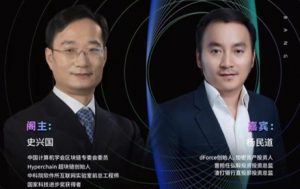
On the evening of October 10th, the 10th episode of the fifth season ” Observing the Langya List ” was broadcasted. and Mr. Shi Xingguo (member of the Blockchain Special Committee of the China Computer Federation, founder of Hyperchain, winner of the National Science and Technology Progress Award, and former chief engineer of the Internet Laboratory of the Software Institute of the Chinese Academy of Sciences) was the host. He talked with Yang Mindao (the founder of dForce). The two experts discussed the topic of “The New Public Chain Competition: Can Move Language Trigger the Next Bull Market?” from different perspectives, with Mr. Shi being a blockchain technology expert and Mr. Yang being a experienced entrepreneur and investor in the field of cryptocurrency.
They effortlessly recalled the history of the development of the crypto industry and discuss various projects like Bitcoin, Ethereum, and the new public chain based on MOVE language. They were able to express their opinions clearly and concisely using the best examples and arguments. Mr. Shi Xingguo believes that the new public chain based on MOVE language currently does not have the potential to become a “killer” of other public chains. If it wants to compete with other public chains, it needs to solve some real problems that the current public chains are facing, such as scalability, security, and credibility. However, the four projects currently using move language have not made any improvements to the chain layer. They are still using the consensus model of the previous generation. In other words, their improvements are made outside of the chain layer. For example, Aptos has proposed many parallel concepts at the move contract layer, including the parallel processing of transactions and then putting them into blocks. But at the chain level, it is still a serial architecture.
Mr. Shi Xingguo stated that “it is important to note that the bottleneck of all current problems is already stuck in the serial architecture. This is why I said that Ethereum has begun to move towards parallel architecture, which means a new era of transformation has begun. It will be difficult for a chain to achieve good scalability at this level if it uses move language but still adopts a serial architecture.”
Regarding the other hot topic of Layer 3, Mr. Yang Mindao believes that the biggest problem with Layer 3 scalability is that it somewhat destroys composability. Currently, there is no composability between assets on Layer 1 and Layer 2. Even if the scalability problem is solved, if liquidity is fragmented, solving the scalability problem actually brings another problem. Of course, different solutions have been proposed, such as solving communication between chains through cross-chain information layers. Currently, the feasibility of the composability between Layer 1 and Layer 2 lies in the fact that they are both under the same chain, so the risks in terms of security and credibility are smaller than those of side chains. However, Layer 3 may broaden security expectations to some extent, which will sacrifice more security expectations to meet performance requirements.
Highlights of today’s talk
- What is the current situation and future trends of the DeFi?
- What determines the value of DeFi tokens and what is the best token design?
- What will be the impact of the Ethereum merger on the DeFi ecosystem?
- Whether embracing regulations will be the fate of public chains?
- How can we comment on Starbucks’ attempts in the Web3 world?
- Whether Move language can trigger the next L1 lift cycle?
- What meaningful L3 looks like?
For more details:
https://huoxun.com/news/42990.html
